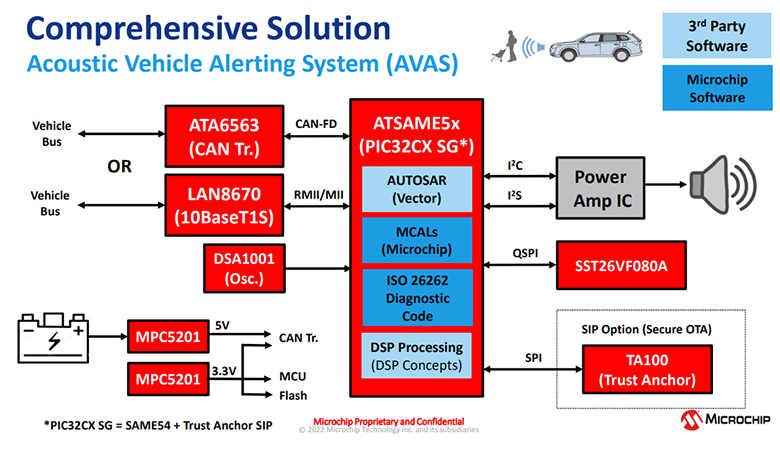AVAS Enhances Safety While Building Brand Reputation for EV OEMs
We help silent Electric Vehicles (EVs) stand out from the crowd.

AVAS Improves EV Safety
Reducing the pollution caused by harmful gaseous emissions is one major benefit associated with Hybrid Electric Vehicles (HEVs) and Battery-powered Electric Vehicles (BEVs). Another feature is that they significantly reduce noise pollution. An electric motor is simply much quieter than an Internal Combustion Engine (ICE).
While ostensibly a welcome development, quiet operation has a consequence that is both unintended and unfortunate. Reduced noise levels make it more difficult for pedestrians and cyclists to hear EVs approaching (Figure 1). These “silent cars” may constitute an even greater safety risk to blind or visually impaired people, especially when they are driven at a low speed, like in parking lots.

Figure 1. EVs are quieter but this makes them dangerous to pedestrians and cyclists.
Data Reveals More Accidents
Studies have examined accident data for electric and hybrid cars and have compared this to the respective numbers of accidents for ICE-powered cars. In their study on the incidence of pedestrian and bicyclist crashes by hybrid electric passenger vehicles, the National Highway Traffic Safety Administration (NHTSA) found that HEVs have a higher incidence of pedestrian and bicyclist crashes than ICE vehicles in certain vehicle maneuvers at low speeds. Likewise, a study conducted by the UK Transport Research Laboratory suggests that proportionately more EVs and HEVs hit pedestrians than ICE vehicles. EVs are 37% and 56% more likely to be involved in accidents with pedestrians and cyclists, respectively.
Regulations Covering Acoustic Vehicle Alert Systems (AVAS)
Regulations have been introduced with the intention of preventing silent HEV and BEV cars from becoming dangerous and the associated reputational damage that this would cause to this relatively new technology. This legislation makes it mandatory for EV vehicles to be fitted with an Acoustic Vehicle Alert System (AVAS) that complies with noise emission standards (EU: UN ECE Regulation 138, USA: FMVSS No. 141, China: GB/T 37153).
Earlier generations of AVAS systems were based on a non-adaptive piezoelectric technology that offers low sound quality and was not customizable. This unimaginative approach represents a lost opportunity for manufacturers. Audio is a medium that touches people’s emotions. AVAS offers a great opportunity for Original Equipment Manufacturers (OEMs) to further advance the image of EVs, enhance the acceptance of E-Mobility and increase their own brand recognition. For example, manufacturers could create their own immediately identifiable signature audio profile that not only alerts pedestrians and cyclists that a vehicle is approaching but can also make them aware of the vehicle’s make and model. The unmistakeable jingles of companies like Intel and McDonald's clearly demonstrate the power of audio in building brand recognition.
Collaborating With Partners to Develop Broad-Based Solutions
According to IHS Markit, 2027 is emerging as the tipping point for an acceleration in EV adoption. Now is the time for manufacturers to begin developing adaptive, flexible AVAS systems that could even be integrated into next-generation infotainment systems. To this end, we are engaging with leading audio system manufactures and new entrants to this market to provide complete solutions that enable the development of next-generation AVAS. Our leadership in automotive infotainment networking delivers uniquely integrated solutions for the future of automotive sound, both interior and exterior. Our broad 32-bit MCU portfolio, which focuses on audio and networking, allows tier one companies to develop customized and flexible solutions that address the evolving AVAS needs including integration, safety and security. Our MCU and MPU portfolio provides graduated level of performance that support scalable solutions, from entry-level solutions that meet legal requirements to higher-performance offerings that enable the most flexible, brand and image-building sound systems.
Comprehensive System Solutions
We're also collaborating with third parties to ensure that a complete ecosystem of industry-standard software is also available. We have developed an AUTOSAR-based demonstration system to showcase how our broad system solutions can help to reduce risk, time to market and development costs (Figure 2).

Figure 2. Comprehensive Solution for AVAS
Our AVAS solutions already operate in production vehicles on the road today. We aim to be at the vanguard of future developments in this burgeoning technology by helping EV OEMs develop AVAS systems that not only enhance the safety of their vehicles, but also make them quickly and easily recognizable to pedestrians and cyclists alike.